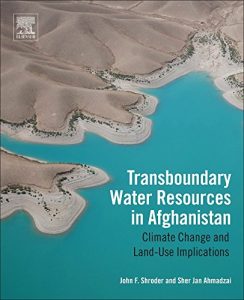Transboundary Water Resources in Afghanistan. Climate Change and Land-Use Implications 1st Edition John F. Shroder – eBook PDF
$50.00 Original price was: $50.00.$35.00Current price is: $35.00.
Transboundary Water Resources in Afghanistan. Climate Change and Land-Use Implications – Ebook PDF
Transboundary Water Resources in Afghanistan. Climate Change and Land-Use Implications – Ebook PDF Instant Delivery – ISBN(s): 9780128018613,9780128018866,0128018615,0128018860

Product details:
- ISBN-10 : 0128018860
- ISBN-13 : 978-0128018866
- Author: Jack Shroder
Transboundary Water from Afghanistan: Climate Change, and Land-Use Implications brings together diverse factual material on the physical geography and political, cultural, and economic implications of Southwest Asian transboundary water resources. It is the outgrowth of long-term deep knowledge and experience gained by the authors, as well as the material developed from a series of new workshops funded by the Lounsbery Foundation and other granting agencies.
Afghanistan and Pakistan have high altitude mountains providing vital water supplies that are highly contentious necessities much threatened by climate change, human land-use variation, and political manipulation, which can be managed in new ways that are in need of comprehensive discussions and negotiations between all the riparian nations of the Indus watershed (Afghanistan, China, India, and Pakistan). This book provides a description of the basic topographic configuration of the Kabul River tributary to the Indus river, together will all its tributaries that flow back and forth across the border between Afghanistan and Pakistan, and the basic elements that are involved with the hydrological cycle and its derivatives in the high mountains of the Hindu Kush and Himalaya.
Table contents:
Part I: Introduction to Physical Characteristics of Water
Introduction
Chapter 1: Characteristics of the Regional Hydrological Cycle
Abstract
1.1 Introduction
1.2 Regional Climate Controls
1.3 Mountain Topography of the Region
1.4 Drainage Systems
1.5 Conclusion
Chapter 2: Hydrogeography (Drainage Basins and Rivers) of Afghanistan and Neighboring Countries
Abstract
2.1 Introduction
2.2 Water Wisdom and War
2.3 Details of Climate Controls in Afghanistan
2.4 Rivers of Afghanistan
2.5 Conclusion
Chapter 3: Ground-Water Geology of Afghanistan
Abstract
3.1 Introduction
3.2 Geologic Overview
3.3 Ground-Water Occurrence
3.4 Ground-Water Geochemistry
3.5 Natural and Human-Caused Contaminants in Ground Water in Afghanistan
3.6 Arsenic in Ground Water in Afghanistan
3.7 Ground Water, Afghans, and Geology
3.8 Qalat Flowing Artesian Well
3.9 Geothermally Impacted Ground Water
3.10 Passive-Seismic Technology for Afghanistan
3.11 Conclusions
Chapter 4: Development of Water Resources in the Kabul River Basin
Abstract
4.1 Introduction
4.2 Geological Background
4.3 New Development of the Kabul River Basin
Chapter 5: H2O Hazards, Risks, and Disasters in Afghanistan and Surrounding Countries
Abstract
5.1 Introduction
5.2 Water-Induced Slope Failures
5.3 Water Floods
5.4 Snow and Ice Hazards
5.5 Droughts
5.6 Conclusion
Chapter 6: Characteristics and Implications of Climate Change in Afghanistan and Surrounding Regions
Abstract
6.1 Introduction
6.2 Regional Climate Change
6.3 Water Security
6.4 Water-Related Hazards in Afghanistan and Climate Change
6.5 Historical Droughts in Afghanistan
6.6 Possible Partial Solutions to Climate and Water Problems
6.7 Science and Policy Linkages in Climate Change
6.8 Conclusion
Part II: Water-Management Issues in Central and South Asia
Introduction
Chapter 7: Modern Water Management Issues in Central and Southwest Asia
Abstract
7.1 Introduction
7.2 Water Measurement
7.3 Water-Balance Accounting Systems
7.4 WA + Withdrawal Sheet
7.5 Applications of the WA + System in Central and South Asia
7.6 Blue-Water, Green-Water, and Gray-Water Paradigms
7.7 Conclusion
Chapter 8: Introduction to the Indigenous Water-Management System in Afghanistan
Abstract
8.1 MIR AAB, the Water Master
8.2 Conceptual Understanding of the MIR-AAB System in Afghanistan
8.3 Evolution of MIR-AAB Concepts in the Present-Day
8.4 Traditional Irrigation Infrastructure
8.5 Historical Phases of Irrigation Development
8.6 Conclusion
Chapter 9: Dams in Afghanistan
Abstract
Acknowledgments
9.1 Introduction
9.2 Background
9.3 Methods
9.4 Helmand River Water Disputes Between Afghanistan and Iran (Table 9.1)
9.5 Helmand River and the Development of the Helmand-Arghandab Development Authority (HAVDA) (Table 9.2)
9.6 Results
9.7 Summary and Conclusions
People also search:
transboundary water issues
transboundary water management
transboundary water issues examples
transboundary aquifer
transboundary water cooperation
water resources of afghanistan



